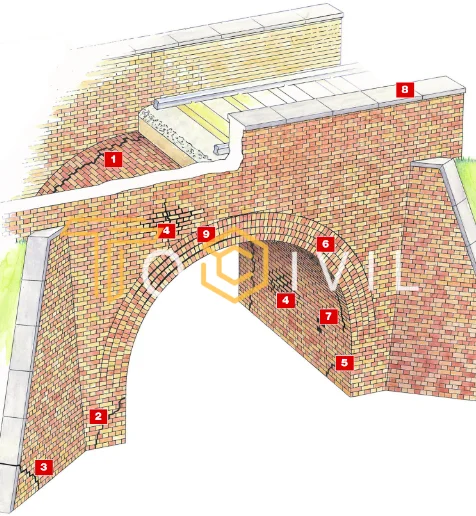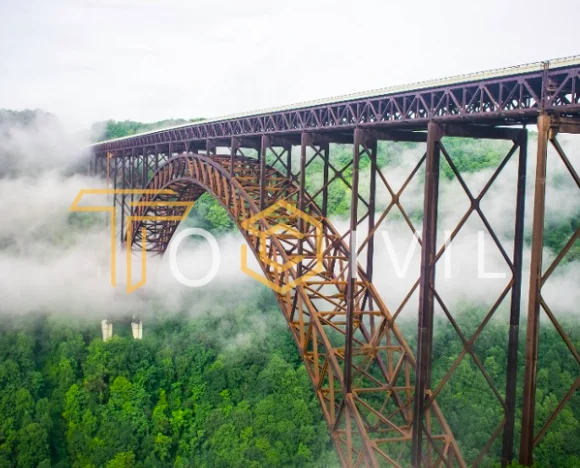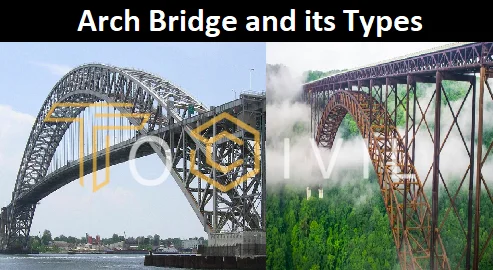Arch Bridge
An arch bridge is a type of bridge that utilizes arches to support the bridge’s weight and the traffic that passes over it. Here are 5 points to explain arch bridges:
- Arch bridges rely on arches’ strength and stability to transfer the bridge’s weight to its supports, typically the ground or pillars.
- Arches distribute the bridge’s weight evenly across their curve, allowing it to span longer distances than other bridges.
- Arch bridges are often constructed of stone, concrete or steel which depends on the design and available materials.
- Arch bridges are known for their aesthetic appeal, as arches can be decorative and add visual interest to the bridge.
- Arch bridges have been used throughout history and are still commonly used today for their strength, stability, and visual appeal. Examples of arch bridges include the Sydney Harbour Bridge, the Pont du Gard in France, and the Rialto Bridge in Venice, Italy.
Stone Arch Bridge
It is a historic bridge in Minneapolis, Minnesota, spanning the Mississippi River. It was built in 1883 and is made of limestone and granite with 23 arches spanning 2100 feet. It was a single Mississippi River bridge in the area at the time it was built. It is a famous attraction for tourists and locals alike. It offers attractive views of the Minneapolis skyline and the river and is a famous spot for walking, running and biking. It is used for many events throughout the year including the Stone Arch Bridge Festival which celebrates art, music and culture.
Old London Bridge
The Old London Bridge was a historic bridge spanning the River Thames in London. It was constructed in the 12th century and experienced several changes and additions with the passage of time. The Old London Bridge was home to over 200 buildings including shops, houses and a chapel. It was the bridge across the Thames for over 600 years and became an iconic London symbol. This bridge connects northern and southern parts of the city and serves as an trade route.
Types of Arches
Arches support weight and span openings in buildings or other structures. There are several types of arches each with its unique design and structural properties. The most common types of arches are given below.
Roman Arch
The Roman arch is an architectural feature developed by the ancient Romans that allowed the construction of larger and more complex structures than possible.
Design and Structure
The Roman arch is characterized by its curved shape, created by a series of wedge-shaped stones called voussoirs. The arch is typically made of stone and consists of a semicircular shape supported by two vertical pillars called piers.
Function and Purpose
The Roman arch was a key feature in many buildings and structures built during the Roman Empire including aqueducts, bridges and triumphal arches. The arch was also used extensively to construct Roman temples, palaces and public buildings.
Construction Techniques
The construction of a Roman arch required careful planning and engineering. The arch was built using a wooden frame called a centring, which supported the arch during construction. The voussoirs were carefully fitted together and held in place by gravity and friction without using mortar.
Legacy and Influence
The Roman arch remains an important symbol of Roman engineering and architectural design. Its influence can still be seen in modern architecture particularly in arches and vaults in churches, cathedrals and public buildings.
Segmental Arch
The segmental arch is an architectural feature characterized by its curved shape, which comprises a series of smaller segments rather than a continuous curve.
Design and Structure
The segmental arch is typically made of stone or brick and consists of smaller arches, or segments, that are joined together to create a larger curve. The segments are typically cut from a larger block of stone or brick and are shaped to fit together tightly without using mortar.
Function and Purpose
The segmental arch was a popular architectural feature during the Renaissance and Baroque periods, particularly in Italy and France. It was utilized in constructing bridges, aqueducts and other public works projects like churches, palaces and public buildings.
Construction Techniques
The construction of a segmental arch required careful planning and engineering. The arch was built using a wooden frame called a centring, which supported the arch during construction. The segments were then carefully fitted together and held by gravity and friction without using mortar.
Legacy and Influence
The segmental arch remains an important architectural feature, particularly in designing bridges and other large structures. Its influence can be seen in modern architecture particularly in arches and vaults in museums, concert halls and other public buildings.
Gothic Arch
The Gothic arch is an architectural feature characterized by its pointed shape, created by two curved lines that intersect at an angle.
Design and Structure
The Gothic arch is typically made of stone or brick and consists of two curved lines that meet at a point. The arch is typically taller than it is wide and is supported by two vertical pillars called piers.
Function and Purpose
The Gothic arch was a famous architectural feature during the Gothic period which endured from the 12th to the 16th of century. It is utilized to construct castles, palaces, churches and other public buildings.
Construction Techniques
The construction of a Gothic arch required careful planning and engineering. The arch was built using a wooden frame called a centring, which supported the arch during construction. The stones or bricks used to build the arch were carefully shaped and fitted together to create the pointed shape of the arch.
Legacy and Influence
The Gothic arch remains an important architectural feature, particularly in designing churches and other religious buildings. Its influence can also be seen in modern architecture, particularly in using pointed arches and vaults in museums, government buildings, and other public buildings.
Tudor Arch
It is an architectural feature famous during the Tudor period in England from 15th to the early 17th century. It is characterized by its flattened arch shape, which is wider than tall.
Design and Structure
The Tudor arch is typically made of brick or stone and consists of a flattened arch with a relatively wide span. Two vertical pillars, called piers, generally support the arch and may feature decorative elements such as carved stone or brickwork.The construction of a Tudor arch required careful planning and engineering. The turn was typically built using a wooden frame called a centring, which supported the arch during construction. The bricks or stones used to construct the arch were carefully shaped and fitted together to create the flattened arch shape.
Function and Purpose
The Tudor arch was used extensively to construct Tudor style buildings including churches, manor houses and other public and private buildings. It was famous in England during the 16th of century.
Construction Techniques
The construction of a Tudor arch required careful planning and engineering. The turn was typically built using a wooden frame called a centring, which supported the arch during construction. The bricks or stones used to construct the arch were carefully shaped and fitted together to create the flattened arch shape.
Legacy and Influence
It is an important architectural feature in Tudor-style buildings and its impact can be seen in the design of other styles of architecture as well. Its flattened arch shape and decorative elements continue to be used in modern architecture, particularly in creating residential homes.
Types of Arch Bridge
There are several types of arch Bridge each with its unique design and structural properties. The most common types of are given below.
Masonry Arch Bridge
A masonry arch bridge is characterized by its use of brick or stone masonry to create an arch that spans a river, valley, or other obstacle.

Design and Structure
The masonry arch bridge typically consists of one or more arches of stones or bricks shaped to fit together tightly without using mortar. The arches are supported by piers or abutments on either side of the obstacle that the bridge is spanning.
Function and Purpose
The masonry arch bridge spans rivers, valleys, and other obstacles for thousands of years. It was a famous architectural feature in Roman era and utilized in constructing aqueducts and designing bridges and other public works projects.
Construction Techniques
The construction of a masonry arch bridge required careful planning and engineering. The arches were typically built using wooden frames, called centrings, which supported the arch during construction. The stones or bricks used to construct the arches were carefully shaped and fitted together to create a tight, stable structure.
Legacy and Influence
The masonry arch bridge remains an important architectural feature, particularly in designing historic and heritage buildings. Its influence can be seen in modern architecture particularly in arches and vaults in museums, concert halls and other public buildings.
Advantages and Disadvantages
One advantage of the masonry arch bridge is its durability and longevity. When built properly, a masonry arch bridge can last for centuries. Constructing a masonry arch bridge can be labour intensive and expensive which makes it difficult to build in areas with limited resources.
Concrete Arch Bridge
A concrete arch bridge is characterized by its use of reinforced concrete to create an arch that spans a river, valley, or other obstacle.

Design and Structure
The concrete arch bridge typically consists of one or more arches that are made of reinforced concrete. The arches are supported by piers or abutments on either side of the obstacle that the bridge is spanning.
Function and Purpose
The concrete arch bridge has been used since the early 1900s to span rivers, valleys, and other obstacles. It is a popular architectural feature due to its strength and durability.
Construction Techniques
The construction of a concrete arch bridge requires careful planning and engineering. The arches are typically built using wooden frames, called centrings, which support the arch during construction. Reinforcing steel bars, or rebar, are placed inside the concrete to provide additional strength.
Legacy and Influence
The concrete arch bridge remains an important architectural feature today particularly in the design of large infrastructure projects such as highways, railroads and airports. Its influence can be seen in modern architecture, particularly using reinforced concrete in buildings and other structures.
Advantages and Disadvantages
One of the advantages of a concrete arch bridge is its strength and durability. Concrete is a strong material that can withstand much weight and stress. Concrete arch bridges require little maintenance and can last many years. Concrete arch bridges can be expensive to build and they are not always aesthetically pleasing.
Steel Arch Bridge
A steel arch bridge is characterized by its use of steel to create an arch that spans a river, valley, or other obstacle.

Design and Structure
The steel arch bridge typically consists of one or more arches made of steel. The arches are supported by piers or abutments on either side of the obstacle that the bridge is spanning.
Function and Purpose
The steel arch bridge has been used since the late 1800s to span rivers, valleys, and other obstacles. It is a popular architectural feature due to its strength and durability.
Construction Techniques
The construction of a steel arch bridge requires careful planning and engineering. The arches are typically prefabricated and then lifted into place using cranes. The arches are then attached to the piers or abutments and reinforced with steel cables.
Legacy and Influence
The steel arch bridge remains an important architectural feature today particularly in the design of large infrastructure projects such as highways, railroads and airports. Its influence can be seen in modern architecture particularly in the use of steel in buildings and other structures.
Advantages and Disadvantages
One of the advantages of a steel arch bridge is its strength and durability. Steel is a strong material that can withstand much weight and stress. Also, steel arch bridges require little maintenance and can last many years. Steel arch bridges can be expensive to build and they are not always aesthetically pleasing.
More Post
FAQ’s
How long is an arch bridge?
The length of an arch bridge differs depending on the structure and purpose of the bridge. Arch bridges can span anywhere from a few meters to over a kilometre. For example the world’s longest arch bridge, the Chaotianmen Bridge in China, spans over 1,600 meters.
Where is the largest arch bridge in the world?
The largest arch bridge in the world is the Chaotianmen Bridge located in Chongqing, China. It has a total length of 1741 meters [5712 feet] and a main span of 1406 meters [4,613 feet] which makes it the longest arch bridge. The bridge was completed in 2009 and served as a major transportation link between the districts of Jiangbei and Yuzhong in Chongqing.
Why arches are the strongest?
Arches are considered one of the strongest architectural structures because of their ability to distribute weight and force evenly. The importance of the structure is transferred outward along the curve of the arch and down to the supports which can be piers or abutments. The arch’s curve also allows it to dissipate the weight and force more efficiently than other structural shapes such as straight beams or columns which are more susceptible to bending and buckling under pressure. Arches can be supported with materials like steel or concrete to further improve their strength and stability.
What is tension bridge?
A tension bridge is a type of bridge supported by wires or ropes anchored to towers or piers at either end of the bridge. The wires or ropes are under tension, which helps keep the bridge’s weight and any traffic or loads that cross it. Tension bridges are also sometimes called cable-stayed bridges, and they are often used for long spans and in locations where traditional suspension bridges are not feasible. Tension bridges can be made from materials like steel, concrete, and natural materials like bamboo.
What are two features of arch bridge?
1- Arch shape: Arch bridges are characterized by their curved arch shape, which helps to distribute weight and force evenly across the bridge and down to the supports.
2- Use of abutments or piers: Arch bridges require abutments or piers on either side of the bridge to support the weight & loads that cross the bridge. These supports are typically made of stone, brick, or concrete and are designed to withstand the compression forces generated by the bridge’s weight.
What is the size of arch bridge?
The size of an arch bridge can differ which depends on the design, purpose and location of the bridge. Arch bridges can range from small pedestrian bridges with spans of a few meters to massive infrastructure projects over a kilometre. The span, or the separation between the two supports on either side of the barrier determines the size of the bridge.
Which bridge is stronger than arch bridge?
Suspension bridges
Suspension bridges are usually utilised for very long spans and can be stronger than arch bridges because of their ability to support heavy loads over long distances.
Cable-stayed bridges
Cable-stayed bridges are similar to suspension bridges but use fewer cables and are better suited for medium-length spans.
Truss bridges
Truss bridges are made of interconnected triangular elements that distribute weight and force evenly across the structure. They are often used for shorter spans than arch bridges but can be stronger in certain situations.
